
I heard about the Haindl Tarot not too long ago through the grapevine of tarot readers I know. Yet this deck was first published back in 1990. Hermann Haindl (1927-2013) is a German artist known for his surreal art and incorporation of mythology.
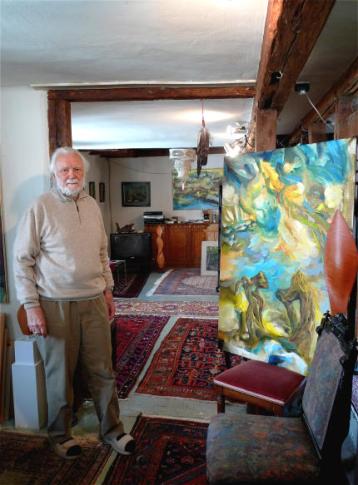
Rachel Pollack has penned companion books for this deck that come highly, highly recommended by pretty much every tarot practitioner I know. I haven’t dived into them yet, but will. At this stage, I’m interested in connecting with the deck directly to see what I can glean, and then I’ll be consulting Pollack’s books on the Haindl.

The Haindl Tarot is a truly remarkable deck for any tarot enthusiast to work with.
For the Majors, each card corresponds with a letter in the Hebrew alphabet per Qabalistic tradition, from The Fool as Aleph, Key 1: The Magician as Beth, Key 2: The High Priestess as Gimel, and so on. Each card also corresponds with an Anglo-Saxon rune. At this point in my personal tarot practice, I don’t work much with Hebrew alphabet or rune correspondences in tarot, but the astrological correspondences on the bottom right corners of the cards excite me.

The paintings are surreal with subdued, subtle coloring. I’ve filtered these photographs to add greater contrast for clarity purposes, but in hindsight I wish I hadn’t. Now you can’t see the light, ethereal quality of the original coloring. In person, the art is not quite as bold as they seem to appear in these photos. The art seems to mirror the stream of consciousness of our minds, which results in an incredibly powerful and evocative tarot deck to work with.
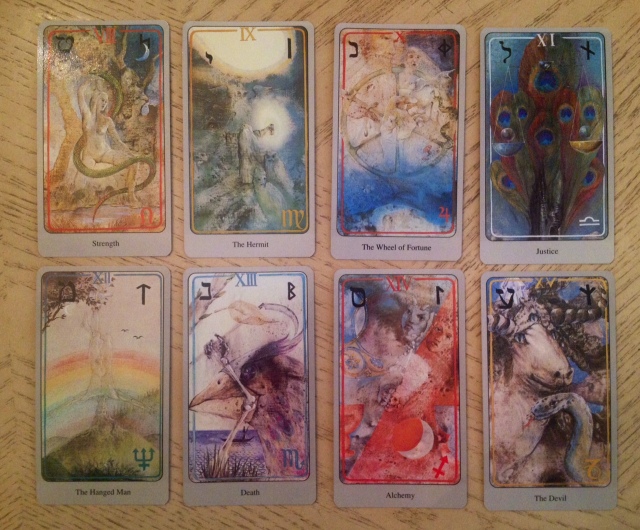
You do see the influence of the Waite numbering in the Majors, with Key 8 here being Strength assigned Leo and Key 11 being Justice assigned Libra. Haindl also appears to order The Fool first, as Key 0, rather than last, at the end of the Majors after Key 21 (as it was in some older traditions).
Yet the abstract imagery here has a Thoth vibe to it. Also, while this deck certainly incorporates darker energies and addresses destructive forces head on, the art itself isn’t immediately daunting to a client, so it would in fact be a pretty good deck to work professionally with. For practitioners who integrate I Ching divination into their tarot readings, this is a great deck for that. More on such a hybrid practice later.

I know everyone disagrees on the directional correspondences in the suits, which is why it’s often left out of decks so that each practitioner can use his or her own correspondences. Here, you see directional correspondences written onto the four Aces. Haindl’s directional correspondences in the Minors differ from mine:
| Suit Name | Haindl Tarot | My Personal Approach |
| Wands | East | South |
| Cups | North | West |
| Swords | South | East |
| Stones (Pentacles) | West | North |
If Haindl’s directional attributions reflect your own, then that’s even more reason to get this deck, because of its convenience of references written right onto the cards. I’m also really liking the keywords. Usually, keywords on contemporary tarot and oracle decks bother me, but here I really like it, like in the Thoth. You’ll also see I Ching attributions in the Minor pips.

However, some of the I Ching correspondences in the Minors caused me to scratch my head. The Seven of Swords, for instance, accompanied by the keyword “Uselessness,” is assigned Hexagram 36, Earth over Fire. In terms of elemental dignities, Papus attributes the Seven of Swords with Air over Fire. Now, granted these terms here sound like we’re all talking about cardinal elements, in the I Ching, we’re talking about 8 trigrams versus the 4 elements in Western tarot.
Hexagram 36 as I interpret it is the “Darkening of the Light,” which in many ways is more Ten of Swords to me. It suggests a transitory period, one where a period of darkness, of inferior overtaking superior forces, of the noble being wounded, is coming to a close soon, and there is light along the horizon. The text for Hexagram 36 sounds very RWS Ten of Swords, if you ask me.
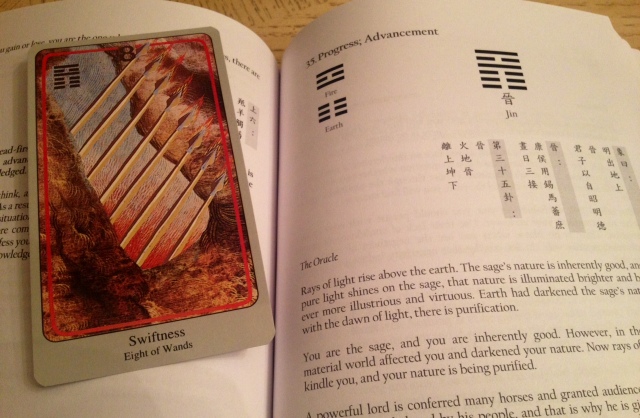
Then others match really, really well, and got me excited. Most of them, actually, worked out really well. Here, for example, Hexagram 35 is assigned to the Eight of Wands. Hexagram 35, Fire over Earth, denotes signs of progress and advancement, and is an auspicious omen for manifestation. You get those same energetic themes in the Eight of Wands.
The Eight of Stones (or Eight of Pentacles) is assigned the keyword “Knowledge” and Hexagram 62, Paying Attention to Details. Hexagram 62 is about laying a strong foundation of knowledge to build upon, focusing on the details and being a perfectionist, being humble about your craft and seeing yourself as an apprentice, with prosperity coming from perfecting what you have, rather than trying to expand at this time. These are all messages I would deliver from the Eight of Pentacles (or Eight of Stones as it is in the Haindl). So for many of the cards, after the tarot reading part, I’d love to note the hexagrams corresponding to the cards drawn for the reading and look them up in the I Ching to offer further insights to a seeker.

The I Ching correspondences are a bit inconsistent, however. I am intrigued by the correspondence of Hexagram 1, Heaven or the Divine Yang to the Two of Cups, Love.
Speaking of Love, in the I Ching, there are four hexagrams commonly associated with romantic love, Hexagrams 31, 32, 53, and 54. Hexagram 31 seems to be about young love, chemistry, and mutual attraction, which I correlate with Two of Cups energy.
Or look at the Eight of Cups, which is assigned Hexagram 27: Corners of the Mouth; Nourishment. Hexagram 27 is considered an auspicious omen, and yet it’s hard to reconcile that, um, auspiciousness, I guess, with the keyword “Failure” written across the bottom of the Haindl Eight of Cups. Hexagram 27, in practical application, often refers to matters of health and wellness, whereas here, I never really got that sense from the Eight of Cups, but hey, that’s just me.

I do love the artwork, however. For those who like to read the cards like a storybook, the imagery here may be a bit tough for that particular technique (whereas the RWS lends itself really well to story reading). Those who interpret the cards either by emotion or by esoteric analysis are going to love this deck.

The suit of Pentacles (or Coins) has been renamed to Stones, which in my opinion works better for the suit and its correspondence with Earth anyway. So I like the Stones.
Let’s choose a card at random to look at for I Ching correspondences. Two of Stones. There you see Hexagram 16: Enthusiasm; Motivation. The Two of Stones seems to be more about harmony, balance, the endeavor of equilibrium. Hexagram 16 is Thunder over Earth, which is about preparing to advance and maybe even auspicious for a hostile takeover. In fact the six lines of Hexagram 16 takes us through the rise and fall of ambition and conquests. It’s very Swords energy, if anything, or maybe Wands. For the Two of Stones, I might opt for Hexagram 42, which is about cooperation and harmony to bring about material gains, and juggling various opportunities while you figure out which one you want to take. That’s very “Two of Pentacles,” wouldn’t you say, RWS readers?

Now we get to the courts, which I love, love, love, love. In the Wands court, we see Hindu (I’ll even say Asian) influences and in the Cups, European, for lack of a better label. There’s Austrian, Norse, Irish, and Germanic influences there.
Wands Court
| RWS | Haindl | ||
| Page of Wands | Princess of Wands | Daughter of Wands in the East | Radha |
| Knight of Wands | Prince of Wands | Son of Wands in the East | Krishna |
| Queen of Wands | Queen of Wands | Mother of Wands in the East | Kali |
| King of Wands | King of Wands | Father of Wands in the East | Brahma |
Cups Court
| RWS | Haindl | ||
| Page of Cups | Princess of Cups | Daughter of Cups in the North | Brigid of Ireland |
| Knight of Cups | Prince of Cups | Son of Cups in the North | Parsival |
| Queen of Cups | Queen of Cups | Mother of Cups in the North | Venus of Willendore |
| King of Cups | King of Cups | Father of Cups in the North | Odin |
The court cards are one of the main reasons the Haindl Tarot shines. I love how multicultural it is and how it brings mythological interpretation into the court card interpretation fold.

The court cards in the suit of Swords is expressed through Egyptian mythology and the Stones (Pentacles), Native American.
Swords Court
| RWS | Haindl | ||
| Page of Swords | Princess of Swords | Daughter of Swords in the South | Isis |
| Knight of Swords | Prince of Swords | Son of Swords in the South | Osiris |
| Queen of Swords | Queen of Swords | Mother of Swords in the South | Nut |
| King of Swords | King of Swords | Father of Swords in the South | Ra |
Stones Court (Pentacles)
| RWS | Haindl | ||
| Page of Pentacles | Princess of Stones | Daughter of Stones in the West | White Buffalo Woman |
| Knight of Pentacles | Prince of Stones | Son of Stones in the West | Chief Seattle |
| Queen of Pentacles | Queen of Stones | Mother of Stones in the West | Spider Woman |
| King of Pentacles | King of Stones | Father of Stones in the West | Oldman |
I’m interested in how the creation myth of the spider woman is incorporated into the Queen of Pentacles, or how Kali is the Queen of Wands (maybe it’s just be, but isn’t Kali more Queen of Swords to you?). Although the goddess Nut works, too, for the Queen of Swords, association Air or sky.
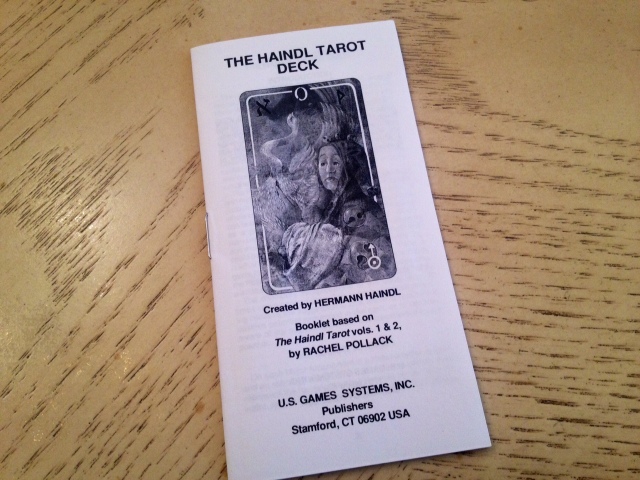


Let’s talk about the little white booklet (LWB). It’s a little white booklet. It suffices. But if the Haindl is going to become one of your staple workhorse decks, then I would suggest looking into Rachel Pollack’s books on the Haindl Tarot.
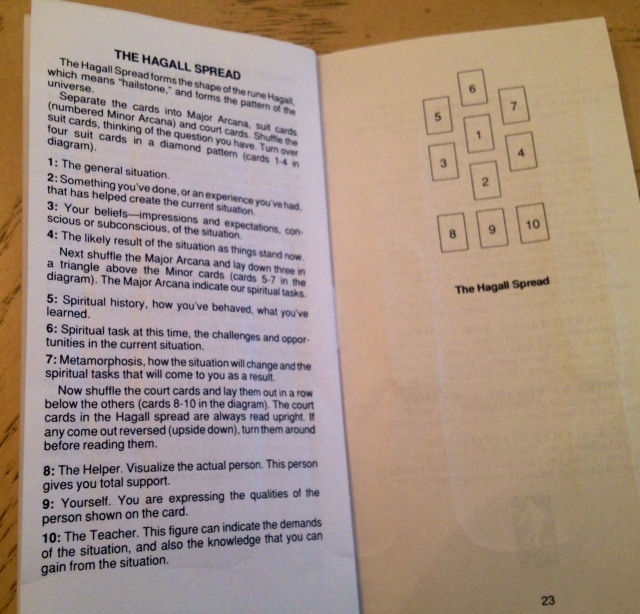
I’m really liking the Hagall Spread that’s taught in the LWB, however.
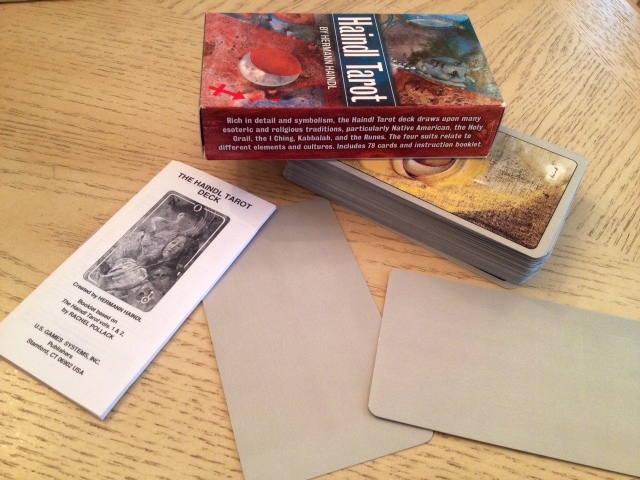
The deck comes with two blank cards. That’s interesting. Typically, the extra cards have publisher advertisements on them or serve as a cover deck for the deck in question. Here, I feel like I want to do something with the blank cards, maybe incorporate it into the deck and use a deck of 80 instead of 78, with the 2 blank ones.
That’s exactly what I did and lo and behold, in the very first reading I did with the Haindl deck, I draw one of the blank cards:

In Hexagram 11, which corresponds with the Two of Swords, titled “Peace,” we see Earth over Heaven, a hexagram about harmony, balance, prosperity, a major synthesis, or holy and auspicious unions. In Hexagram 11, there is a sense of upper and lower classes uniting in concord. It’s the intercourse between heaven and earth.
I think my personal interpretation of the Two of Swords would be better reflected in Hexagram 12, which is Heaven over Earth. In Hexagram 12, we get a plateau, stagnation, stalemate, an impasse. Hexagram 12 indicates small gains at the price of significant losses. I often get that vibe from the Two of Swords, at least more so Hexagram 12 energy than Hexagram 11, which feels like too harmonious a hexagram for a Swords pip.
The Haindl Tarot has quickly risen to be one of my all-time favorite decks. There is so much here to work with, even if some of the correspondences don’t resonate with my own personal practice.

How funny, I’m expecting this deck in the mail today; the day I saw your review go live.
LikeLike
That is funny! Let me know how you like it!
LikeLike
This is one of my favorite decks! I haven’t even begun to study the I Ching (although someday…) and Rachel Pollock’s book is on my wishlist. Still, I feel there is so much to read in these cards without having all that extra information. These cards are evocative and expressive, the symbolism is just the details.
LikeLike
I agree! Some of the corresponding I Ching hexagrams cause me to scratch my head a bit, but ultimately, it does work. When a card comes up in a reading with a hexagram, I’ll look up that hexagram in the I Ching and add an I Ching divination to the tarot reading. As for the runes, that’s what I’m learning right now so I can make the most out of this deck! =)
LikeLike
When I started to hang out at Aeclectic Tarot forum in 2004-2005 this deck was very much talked about! It was considered a “very advanced” deck since it incorporates so many different methods and traditions. Since I was a newbie back then I didn’t care for it, it felt too difficult for me, and probably it wouldn’t have worked for me back then actually. I like the art of the Haindl but I’ve never been interested in the I Ching, and I’m personally not very fond of those court cards. 😉 I can’t let go of the old feeling that it feels like a really advanced deck lol… But I can see how it would fit some readers. It seems ideal for you Benebell!
LikeLike
Ooh! I love the court cards in this deck! =) Haha yes, it is pretty ideal for me. =) When I use this deck, I don’t draw that many cards, because each card goes so in-depth. I not only read it for the classic meaning associated with the card, but also look at the hexagram or rune it corresponds with. Which decks are your go-to tarot decks?
LikeLike
I can definitely imagine each card in the Haindl gives A LOT of info. 🙂 I kind of feel the same with my Ludy Lescot, I don’t need big spreads for it, most of the time 3 cards are enough. A huge spread would just feel confusing probably… And would make me do a reading for hours?! LOL.
I think my current go-to tarot decks are standard RWS (always hehe), Crystal Visions, and Dame Darcy’s Mermaid Tarot. 🙂 I think when fall comes I’ll be more drawn to the decks that are a little darker, like the Ludy Lescot and Russian Tarot of St Petersburg. What are yours? 🙂 You have such an amazing collection from what I’ve seen!
LikeLike
This is one of my favourite decks. Like many, I cut the grey borders with the key words off my deck (this may be heresy to you). I had the jumbo Haindl anyway, so even borderless it is larger than some tarot decks. It’s a wonderful deck, and one of the most earth-centric I’ve ever used. It really makes me feel connected to the Gaia aspect of our planet, and our relationship to her, the good and the bad. (Lots of bad depicted in this deck). For me, it has a very poignant, holding-back-the-tears sort of feel to it.
LikeLike
Pingback: The 3x3x3 Tag: Tarot, Oracle, and Other | benebell wen
Pingback: The Wooden Tarot Deck Review | benebell wen
Pingback: Tarot Video Challenge: Day 2 - Sue Ellis-Saller
VERY helpful and insightful review of the Haindl tarot! Thank you for such a thorough descriptive.
LikeLike
Great review.
I would like to ask if you can recommend a good book for I-Ching hexagram explanations and in general. Very much appreciate it.
LikeLike
Haha well I am for sure biased. Because I would recommend my I Ching course, which comes with my translations and annotations of the Book of Changes, i.e., a book that explains the I Ching hexagrams. 😀
LikeLike
Thank you for the recommendation and it is a great pick up. Your book Holistic Tarot arrived yesterday and it´s such a well written book. Just keep writing.
Where do I find your I Ching course?
LikeLike
One note: what I use the blank cards for is keeping the majors, minors, and court separated–to faciliate the three groups of cards required for the Hagall spread.
LikeLike
I’ve been drawn to this deck since the day I purchased it. I was a deck collector first for the art and inspiration. Only decided to start learning Tarot VERY recently. But I assumed I need to start with the RWS first. But I’m finding myself a little impatient in trying to learn the RWS because I am trying to learn it only to “get to” the Haindl 😦
LikeLike
Pingback: Linkage: Ritual nudity, fairy tales, and long hair | Spiral Nature Magazine
Wondering these some years later if the Haindl is still one of your all time favorite decks?
LikeLike
I am somewhat of a novice. But, I feel Wands works for Kali, she is very firey! I don’t get where he got the directional associations, I would agree with you there. I also heard on Elle’s Sacred Seed Channel (mysterious how she just dropped out of sight), that she did not agree the line up on the hebrew letters, that she followed the Wirth school, not the Crowley school in that regard. It is interesting to note your discrepancies with his iChing designations in some cases… I am very drawn to the deck, but I do see already, there are places, if I get it, I will need to delve deeply to make my own associations, it is not an off the self slam dunk, but then nothing ever is!
LikeLike
Hi, the review says 8ofCups is assigned to hexagram 27, but I think the picture shows it is hexagram 41 (“Decrease”). That probably matches your view of the card better than “Nourishment”!
LikeLike